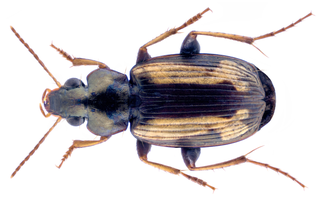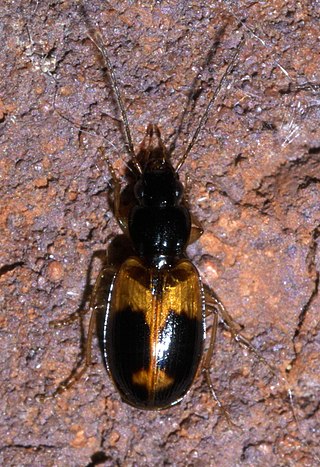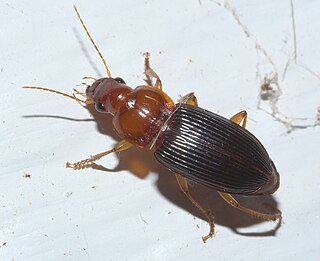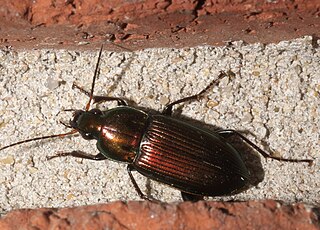
Brachinus is a genus of ground beetle native to the Nearctic, Palearctic, the Near East and North Africa. Beetles in this genus are commonly referred to as bombardier beetles. The genus contains the following species:

Lebia is a genus of predatory ground beetles. Common names include colorful foliage ground beetles and flat ground beetles. They are found worldwide and there over 700 species in 17 subgenera.

Anthiinae is a subfamily of beetles in the family Carabidae, containing the following genera:

Leptotrachelus is a genus of ground beetles in the family Carabidae. There are more than 30 described species in Leptotrachelus.

Amblystomus is a genus in the beetle family Carabidae. Its species are found mainly in Africa, Asia, Europe, and Australia.

Tetragonoderus is a genus of beetles in the family Carabidae.

Demetrida is a genus in the beetle family Carabidae. There are more than 100 described species in Demetrida.
Merizomena is a genus in the beetle family Carabidae. There are about 13 described species in Merizomena.

Licininae is a subfamily of in the beetle family Cicindelidae. There are more than 80 genera and 1,800 described species in Licininae.

Caelostomus is a genus of beetles in the family Carabidae. It contains the following species:

Scaritinae is a worldwide subfamily of beetles in the family Carabidae, containing more than 2400 species in over 140 genera.
Aspidoglossa is a genus of beetles in the family Carabidae. It is found primarily in the Neotropics with one species, Aspidoglossa subangulata, in the United States.
Clivina aucta is a species of ground beetle in the subfamily Scaritinae. It was described by Wilhelm Ferdinand Erichson in 1843. It has two subspecies: Clivina aucta aucta and Clivina aucta aethiopica.
Clivina laevifrons is a species of ground beetle in the subfamily Scaritinae. It was described by Maximilien Chaudoir in 1842.
Nupserha basalis is a species of beetle in the family Cerambycidae. It was described by Wilhelm Ferdinand Erichson in 1843. It has a wide distribution in Africa.

Harpalini is a tribe of a diverse group of ground beetles belonging to the subfamily Harpalinae within the broader family Carabidae. The tribe contains more than 1,900 species.

Pterostichini is a tribe of ground beetles in the subfamily Harpalinae. There are about 180 genera and more than 3,800 described species in Pterostichini.
Jules Antoine Adolphe Henri Putzeys was a Belgian magistrate and an entomologist who took a special interest in the beetles belonging to the family Carabidae.
Pseudotetracha is a genus of tiger beetles in the family Cicindelidae, formerly included within the genus Megacephala, and endemic to Australia.












